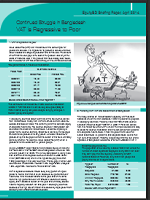 Value Added Tax (VAT) is an indirect tax on the consumption of goods and services. It is imposed on a product or service whenever value is added at a stage of production and at final sale. The amount of VAT that the user pays is the cost of the product, less any of the costs of materials used in the product that have already been taxed. So, the burden of VAT falls almost entirely on the ultimate consumers
Value Added Tax (VAT) is an indirect tax on the consumption of goods and services. It is imposed on a product or service whenever value is added at a stage of production and at final sale. The amount of VAT that the user pays is the cost of the product, less any of the costs of materials used in the product that have already been taxed. So, the burden of VAT falls almost entirely on the ultimate consumersIn developing countries about two-thirds of the tax revenue comes from indirect taxes, mostly from VAT and others are from sales tax, excises and taxes on trade. The remaining one-third consists largely of corporate income tax. Tax revenue structure in Bangladesh can be divided into direct and indirect taxes. A direct tax is paid by a person to the revenue authority. Direct tax is borne by the tax payer and cannot be passed on to any person, whereas indirect tax is passed on by the tax payer so that the burden of the tax is ultimately borne by another. For example, Value Added Tax (VAT) which is passed on to the customers i.e. general people
Download the document [ VAT is regressive to poor ] as pdf









